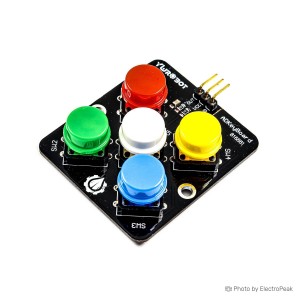A membrane matrix keypad and a flat matrix keypad are both essential input devices with distinct design and functionality characteristics. The membrane matrix keypad features a slim design with buttons integrated into a flexible membrane, providing a compact and tactile input solution. On the other hand, a flat matrix keypad, while also compact, has buttons with a flatter surface and a more straightforward layout. The key difference lies in the tactile feel and the design aesthetics, making the choice between them dependent on the specific project requirements. Membrane keypads often offer a softer touch, while flat matrix keypads provide a sleek and modern appearance.
Keypad & Joystic
What is Keypad & Joystick:
Keypads and joysticks are versatile input devices widely used in electronics and robotics projects. Keypads, such as the 4x4 and 4x3 Membrane Matrix Keypad Module and the 1x4, 3x4, and 4x4 Flat Matrix Keypad, provide a tactile interface for users to input commands or numerical values. These modules are integral in designing user-friendly interfaces for electronic devices. On the other hand, joysticks like the Dual-axis XY Joystick Module and Dual-axis Joystick Shield for Arduino offer precise control over two axes, making them ideal for applications such as gaming or robotics. These input devices enhance the interactivity and functionality of various electronic projects.
Price of Keypad & Joystick:
The cost of keypads and joysticks varies based on factors such as the type, brand, and additional features. Entry-level membrane keypads are budget-friendly options suitable for basic projects, while advanced capacitive touch keypads and high-precision joysticks may come at a higher price point. When considering a keypad or joystick, it's crucial to evaluate the specific requirements of your project, balancing functionality with your budget to make an informed purchase decision.
Tips for Buying Keypad & Joystick:
When buying keypads and joysticks, consider the type of input required for your project. Membrane keypads are excellent for standard button input, while capacitive touch keypads offer a more modern and sleek interface. For joysticks, assess the number of axes needed for precise control. Additionally, check compatibility with your microcontroller or platform. Reading product reviews and user feedback can provide valuable insights into the durability and performance of the keypad or joystick you are considering, ensuring it meets the specific needs of your electronic project.
All Types of Keypad & Joystick:
4x4 and 4x3 Membrane Matrix Keypad Module: Ideal for projects requiring a compact and responsive button interface.
1x4, 3x4, and 4x4 Flat Matrix Keypad: Versatile keypads suitable for various input applications with flat and ergonomic designs.
4x4, 2x4, 1x4 Micro Switch Matrix Keypad: Featuring micro switches for a tactile button press experience, suitable for user-friendly input.
Wireless Shock Game Controller for Sony PS2: Designed for gaming applications, providing wireless freedom and responsive controls.
Dual-axis XY Joystick Module: Offering precise control over two axes, perfect for robotics and drone projects.
Dual-axis Joystick Shield for Arduino: An Arduino-compatible shield that integrates a dual-axis joystick for seamless control in Arduino-based projects.
XD-62B TTP229 4x4 Capacitive Touch Keypad: A modern touch keypad using capacitive technology for a sleek and responsive input experience.
MPR121 3x4 Capacitive Touch Keypad Module: Capacitive touch technology in a 3x4 layout, suitable for projects where a touch-sensitive interface is preferred.
How does a membrane matrix keypad differ from a flat matrix keypad in terms of design and functionality?
Can capacitive touch keypads like the XD-62B TTP229 be used in outdoor or harsh environments?
Capacitive touch keypads, such as the XD-62B TTP229, are generally not recommended for outdoor or harsh environments due to their sensitivity to environmental conditions. These keypads rely on changes in capacitance, which can be affected by factors like moisture, extreme temperatures, or dust. For outdoor applications, it's advisable to use keypads specifically designed for harsh conditions, such as sealed or ruggedized keypads. These are built to withstand environmental challenges and ensure reliable performance in outdoor settings. When choosing a keypad for a project, always consider the environmental conditions to guarantee the longevity and functionality of the device.
Are there specific programming considerations when working with capacitive touch keypads like the MPR121?
When working with capacitive touch keypads like the MPR121, programming considerations are crucial to ensure optimal functionality. Capacitive touch keypads operate by detecting changes in capacitance when a user touches a button. In programming, debounce algorithms are commonly used to filter out false or unintended touches, enhancing the accuracy of input detection. Additionally, sensitivity settings can be adjusted to fine-tune the responsiveness of the keypad. Understanding the programming nuances of capacitive touch technology ensures that the MPR121 or similar keypads effectively interpret user input, delivering a reliable and responsive touch experience in electronic projects.
Can the 4x4 and 4x3 membrane matrix keypad module be easily integrated with microcontrollers like Arduino?
Yes, the 4x4 and 4x3 membrane matrix keypad modules can be easily integrated with microcontrollers like Arduino, making them popular choices for electronic projects. These keypads typically have a simple wiring configuration, with each button corresponding to a unique electrical signal. By connecting the keypad to the digital or analog pins on an Arduino board, users can utilize libraries or write custom code to interpret button presses. The flexibility and compatibility of these membrane matrix keypads make them user-friendly for Arduino enthusiasts and beginners, providing an accessible means to incorporate tactile input into a wide range of projects.
